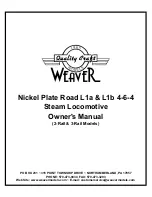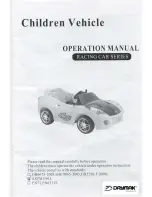
•
This model is not suitable for young persons under 14 years of age.
•
You must
NEVER
operate this model boat when there are persons or animals in the water,
otherwise there is a serious risk of causing injury.
•
Never run your boat in protected sites, animal or plant sanctuaries or sites of special scientific
interest (SSSIs). Check with your local authority that the stretch of water you wish to use is
suitable for model boats.
•
Do not run the model in salt water.
•
Never run your boat in adverse conditions, e.g. rain, storm, strong wind, choppy water or strong
currents.
•
Before you run the model check that the radio control system is working reliably, and that all
connections are secure.
•
The batteries must be charged and the range of the radio control system must be checked before
you run the model. In particular the radio control system batteries must be fully charged before
each session.
•
Ensure that the channel you intend to use is not already in use by other modellers. Never run the
boat if you are not certain that your channel is free.
•
Read and observe the instructions and recommendations provided by the manufacturer of your
radio control system and accessory components.
•
Do not work on the power system unless the motor is disconnected from the drive battery.
•
When the drive battery is connected, keep well clear of the area around the power systems, as
this represents the greatest risk of accident and injury. Make sure any spectators do the same.
•
Do not exceed the recommended voltage of the drive battery. Increasing the voltage may cause
the motor and/or the speed controller to overheat, and the electrical leads can even melt. In the
worst case this may cause the model to go up in flames and be completely ruined.
•
Check that all the drive train components work smoothly and freely. This applies in particular
when you are running the model, as leaves and other detritus can get caught up in the power
system. If this happens and you do not remove the obstruction, the motor, speed controller or
rudder servo may be ruined due to overloading.
•
Ensure that the servos are not mechanically obstructed at any point in their travel.
•
Dry cells and rechargeable batteries must never be short-circuited. Do not allow them to come
into direct contact with water.
•
Allow the drive motors and speed controller to cool down after each run. Don’t touch the hot
surfaces!
•
Remove all batteries from the model prior to transporting and storing it.
•
Do not subject the model to dirty or cold conditions, or high levels of humidity or heat.
•
Secure the model and your RC equipment carefully when transporting them. If they are free to
slide about, they may be seriously damaged.
•
If you wish to operate the model on moving water (e.g. a river), remember that it could be washed
away downstream if the battery fails or a malfunction occurs.
•
If you have to salvage the model, take care not to risk your own life or those of others.
•
Check regularly that the boat is completely watertight, as it may sink if too much water enters the
hull. Check the boat for damage before every run.
•
Take great care to prevent water entering the boat. Apply tape all round the removable hatch to
make it watertight.
Care and maintenance
•
Clean the model carefully after every run, and remove any water which penetrates the hull. If any
of the receiving system components should get wet, dry them out immediately and have them
checked by your local GRAUPNER service centre.
•
Clean the model and RC components using suitable cleaning agents only. Ask your model shop
for information.
Notes on building the model
•
Before building the boat it is important that you study the plan and read the instructions right
through to the end. Use the parts list constantly as an aid to construction. The instructions and
parts list reflect the sequence of assembly.
•
The instructions do not describe every single operation in assembling the parts; they concentrate
on important points, and should be considered as a supplement to the plan.
•
Tools can be dangerous; be aware of the hazards involved in using them.















































